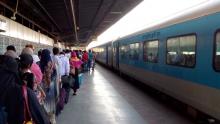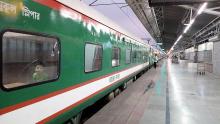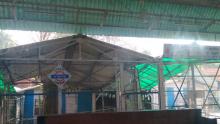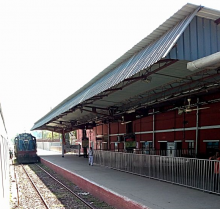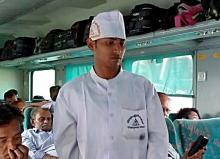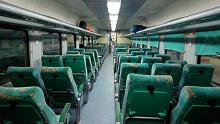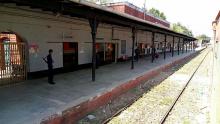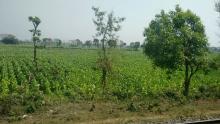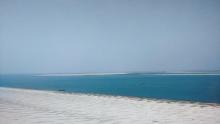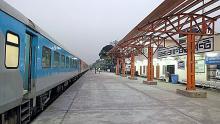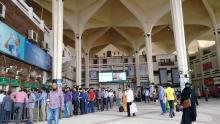The Maitree Express
Text by Sudakshina Kundu Mookerjee
Photograph by Koushik Majumder
It was a long cherished dream to travel to Bangladesh by the Maitree Express, crossing the border between the two countries that once used to be a united Bengal. Maitree Express started commuting between the Capitals of the two Bengals, Kolkata (Calcutta) in the West in India and Dhaka in the East, in Bangladesh. It was officially flagged off on April 14, 2008, the day both the Bengals were celebrating the Bengali New Year. Old Chitpur yard was cleared and a passenger terminal was built to accommodate this truly international train that travelled 375kms from Kolkata International terminal to Dhaka Cantonment Station. Earlier it used to take more than eleven hours to complete the journey as much time was spent at the border posts of Gede in India and Darshana in Bangladesh to complete the immigration formalities. Since November 2017, the Kolkata terminal has been upgraded with immigration office so that the formalities can be completed before the journey begins. Dhaka Cantonment Station also has its immigration centre next to the arrival platform. The journey time has therefore been cut down by two hours.. The train starts at 7.10 am (IST) from Kolkata and reaches Dhaka Cantonment Station around 4.10 pm (BST). There are four pairs of trains running between Kolkata and Dhaka, two pairs of each of Indian Railways and Bangladesh Railway.
The train traces the route of the erstwhile Eastern Bengal Railway Company or EBR for short, a pioneering railway company that operated for ninety-five years from 1857 to 1942, in the Bengal and Assam provinces of the British India. Eastern Bengal Railway Company was established through an Act of the British Parliament in August 1857, with an intention to provide railway connectivity to the entire Bengal area lying to the East of river Hooghly. EBR then stretched as far as Burma. It functioned independently till 1884, before being taken over by the Government and renamed Eastern Bengal State Railway. In 1887, the Calcutta and South Eastern Railway merged with it. The Railway reverted back to its old name “Eastern Bengal Railway” in 1915 and expanded in 1941 by including Bengal Doors Railway. Soon Assam Bengal Railway was added to it and the railways jointly came to be known as Bengal and Assam Railway. Assam Railway merged with Oudhand Tirhut Railway to form the North East Railway on April 14, 1952, with its head quarters in Gorakhpur. The Sealdah division of the erstwhile EBR became part of Eastern Railway. Remaining portion of the Eastern Bengal Railway that fell into East Pakistan was first renamed Pakistan Railway and then changed to Pakistan Eastern Railway from 1962. After Bangladesh became independent in 1971, this railway became Bangladesh Railway.
The first tracks of the EBR laid between Calcutta and Kushtia in 1862, covered Sealdah - Ranaghat and Ranaghat - Gede lines of the present day Sealdah division of the Eastern Railway. In Bangladesh the track was part of the Chilahati-Parbatipur-Santahar-Darshana line. Our aim was to travel by this historical line and relive many of the stories of undivided Bengal that were handed down to us through generations. Rabindranath Tagore spent his youth in Silaidaha, looking after his ancestral property. His reminiscences of East Bengal have mesmerized us. Many of the renowned litterateurs of Bengal who hailed from East Bengal also left behind memorable impressions of this beautiful country.
Ourdream came true when we boarded the Maitree Express from the Kolkata station in the wee hours of March 3, 2018. Dawn was just breaking. Long line of travellers had already queued up in front of the immigration counter on the platform of the Kolkata Terminal, separated from the rest of the railway station by barbed wired perimeters. Although all the passengers were advised to report two hours in advance, the immigration check was done rather efficiently and fast. Our traveling tickets were inspected, berths were allocated and we boarded the train that was already standing on the platform. The waiting hall has not come up yet, although the station has seen much improvement since its inception in 2008.
It was not yet 6.00 am and once the checking was done we were not allowed to leave the platform. So it was a long wait for the scheduled departure at 7.10am. It was Saturday and the rake was that of the Bangladesh Railway. The train was painted a deep green and marked in Bengali letters. Inside the compartment all the instructions were in Bengali, a departure from the compartments of the Indian Railways where the notices are bilingual, in Hindi and English. All other features of the train were very similar to the trains run by its Indian counterpart. As we waited inside the compartment the prayer call of the Muezzin resonated from the nearby mosques, a call to usher in the day.
The train started precisely at 7.10 am. There was heavy security in the platform. Smartly uniformed Border Security Force (BSF) personnel of both gender boarded the train and stationed themselves near the exit doors of each of the compartments. There were eleven coaches, including the engine and the power car. The entire train was air-conditioned. There were two categories of seats, the AC first and the AC Chair cars. While travelling from India each first class compartment has four seats. On the journey from Dhaka to Kolkata, six passengers share each of these compartments.
The train traveled slowly, winding its way out of the Kolkata station to meet the track that came from Sealdah North section. We went past South Dumdum, Belghoria, Agarpara, Khardaha, Barrackpur, Palta, Ichhapur, Shyamnagar, Jagaddal, Kankinara, Naihati, Halisahar, Kanchrapara, Kalyani, Simurali, Palpara, Chuadanga and Ranaghat. The train track forked after Ranaghat and our train took an easterly turn towards Gede, the last post on the Indian side. After travelling past Bankimnagar, Santinagar halt, Majhdia and Banpur, it reached the border. The Indian Railway Catering and Tourism Corporation (IRCTC) was serving tea and coffee. The payment was done in Indian currency. The Bangladeshis who were going back from India spent their surplus Indian currency by buying loads of chips and other goodies sold by IRCTC.
We reached Gede in about two and half hours, a distance of about 114 Km. The platform was highly fortified on all sides. Once again barbed wire fences separated the platform from the world outside. The BSF personnel disembarked from the train. There was a change of crew. The Indian side handed over the train to their counterparts from Bangladesh. The train stopped for a while and when it started again we slowly moved through the no-man’s land and entered Darshana, the border post on the Bangladesh side, 130 kilometers away from the originating station. Our mobiles had already stopped working at Gede. As we entered Darshana we were out of communication. I carried an International roaming SIM, which I activated. That was our only link to the outside world. It was so near, yet so far!
As soon as the train started, the “Khansamas”, as the serving crew is called in Bangladesh, came in their starched white uniform and white caps, to offer beverages. Lunch was served early. As there was no pantry car, the food was collected from Darshana and was served before it became too cold. The lunch packs consisting of “Chicken biryani” were served before noon to those who cared to buy them. The Khansama, was a very amiable young man. He volunteered to serve us snacks later if we cared to have more.
From Darshana, the train retraced the path laid down more than a century ago. We travelled past Joyrampur, Chuadanga, Mominpur, Munshigunge, Alamdanga, Halsa, Poradaha, Mirpur and Bheramara, the names ringing bells in our mind.
As we travelled across Bangladesh the landscape turned greener. The semi urban habitat of West Bengal was soon replaced by a rural, agrarian East Bengal. The crop appeared a little different. At this time of the year, after the autumn harvest, the fields in the Indian side cultivate vegetables and mustard. The fields have patches of golden among the viridian green of the vegetable gardens. In Bangladesh they were cultivating paddy. The fields were lush green with freshly planted saplings. There were mango orchards and banana plantations, interspersed with small hamlets, pristine ponds and tin-roofed huts under sprawling Banyan trees. Here and there the green minarets of local mosques raised their heads. Other than these small differences, the entire landscape looked so similar to the agrarian countryside of Malda or Murshidabad districts of West Bengal. Near Kushtia there was a heavy cultivation of tobacco as this area had many factories that rolled country made cigars or “bidi”.
The train then came to Padma river that had to be crossed by the famous Hardinge Bridge. This 1.8 kms long iron bridge, in Pabna district, was built in 1915 to link the west bank of this great expanse of water with the east. It was located between Bheramara to the west and Pakshi and Iswardih stations in the east. Before the train crossed the bridge there was an announcement in Bengali, requesting the passengers not to open the doors or lean out. They were also advised against using the toilets as that would lead to rusting of the iron and damage the century old historical structure. This bridge was damaged twice since its inception; once during the World War II, and again in 1971 when the Bangladesh war raged. Each time it was rebuilt and the bridge had stood the test of time. Naturally we were anxious to cross it and witness the legendary Padma river for the first time. Unfortunately at this point Padma is much narrower than we expected it to be. However, the river was alive with motorized boats and barges overloaded with sand and other merchandise.
Gradually the green fields gave way to small towns whose names had become legends to us from reminiscences of people who had relocated to India after partition in 1947 or after the Bangladesh war.
The journey was slow as we were traveling down a single line section. We had to stop at stations to give way to other trains. These stations wore a very old world look as they still retained the stamp of the old Eastern Bengal Railway. The high roofed brick station buildingswith arched doors, looked enchantingly like pictures of a bygone era. The slanting roofs on the platform balanced on curved iron pillars, had a quaint character, which transported me back to the memories of undivided Bengal, handed down to us. There were long benches on the platforms where men in long kurtas, sporting beards, sat hunched with their women folk wearing colourful burqas.
The local trains that ran on these tracks had passengers climbing all over the locos and sitting in hoards on the roof of the compartments, although it was not crowded inside. Train after train passed with passengers inside as well as huddled on roof.
The greatest feast for the eyes was still awaited. Soon we crossed the mighty Yamuna river by the multi-purpose bridge called “Bangabandhu Setu”. Brahmaputra in Assam is renamed Yamuna in East Bengal. The huge expanse of blue water shimmered in the sunlight. The golden sand banks gleamed. It was a wonderful sight, the first vision of Bangladesh, as a land of many rivers!
We gradually drew close to Dhaka. We crossed the famous town of Tangail. Once upon a time it was famed for weaving. Many of the weavers have since relocated to West Bengal and settled down in Fulia and Santipur towns of the district of Nadia, to carry on their trade. Tangail too has its quota of looms with their distinctive style of weaving.
The rural scenery by then had given way to suburban landscape. Taller buildings were raising their heads. The towns were getting more congested, much like the townships in the Indian side. Corrugated roofs were replaced by concrete structures. Pristine ponds changed to over spilling drains and swamps, the inevitable stamp of urbanisation. We were entering Dhaka, one of the most crowded cities of the world. We crossed Tongi and finally the train came to a halt at the Dhaka Cantonment Station.
We poured out of the train and queued up for customs. It was well past four thirty in the evening by Indian standard time. Bangladesh time was around 5 pm.
The sun in its golden-orange glory was setting behind the tall buildings. It took us about half an hour to complete all the formalities. By the time we were outside the station dusk was settling in. The Cantonment station was of medium size with a “four window” booking counter outside the immigration office. Under a tarpaulin shade some plastic seats were kept for people to wait till their vehicles arrived. Since our pick up was held up by the famous traffic jam of Dhaka, it was late in arriving. We waited with great expectation, oblivious of the mosquito bites, savouring the beautiful memory of our train journey.
Uploaded by SANJOY MOOKERJEE

